A rectangular, in-ground concrete tank in Ontario, Calif., had poor circulation and low turnover, and it suffered from excessive water age. During the winter, this tank showed good water quality. But because of thermal loading on the roof in the summer, stratification between top and bottom would build to almost 16°F, which would isolate the top water from the rest of the reservoir, leading to complete residual loss and acceleration of bacterial and biofilm growth.
The Solution
In-ground tanks have a wide range of shapes, and nearly all have numerous columns to support the roof. These columns can act as baffles, inhibiting flow and challenging the action of most mixing systems. Because of these challenges, operators at Ontario chose the PAX Water Mixer because of its compact size and the fact that it pumps a great deal of water.
PAX staff ran a detailed computational fluid dynamics (CFD) model of the reservoir to ensure that the system would adequately mix the tank. CFD is a powerful tool for revealing the dynamics of flow in a system (such as an underground water tank) where direct velocity measurements would be difficult. The CFD model showed that, despite the presence of numerous columns, the flow pattern created by the PAX Water Mixer mixed the entire contents of the reservoir—even out to the far ends of the basin.
A two-man diving crew installed the PAX Water Mixer on July 24, 2007. The complete installation took less than three hours. The underwater assembly of the mixer took less than 30 minutes.
After installation of the mixer, the staff at Ontario saw immediate improvements. In just 14 hours, the stratification was reduced from approximately 16°F to less than 1°F, and total chlorine residual measured at the exit of the tank rose from 0.5 ppm to 0.65 ppm in less than 48 hours. This increase in residual was caused by mixing fresh residual-rich incoming water with residual-depleted water in the top layers of the reservoir.
The circulation of residual to all parts of this reservoir not only arrested further biofilm growth and residual loss, but it also lowered the air temperature in the headspace, further slowing residual loss from evaporation.
The PAX Water Mixer has the ability to break stratification within a few hours of startup and then maintain a uniform temperature throughout the tank. This type of rapid, complete mixing is made possible by the strong axial jet of colder water from the bottom of the tank, which breaks through established thermoclines, and the coherent toroidal flow structure set up by the PAX mixing impeller, which facilitates mixing of large water volumes—even in tanks with numerous support columns.
The Conclusion
Chemical and temperature data show a significant positive gain after the installation of the PAX Water Mixer. Stratification in the 2.75-million-gal in-ground concrete tank was virtually eliminated, and chlorine residual at the outlet of the tank increased by 25% over just a matter of days. Additionally, the maximum temperature in the reservoir was significantly reduced. This temperature reduction is important because a higher temperature promotes a more rapid loss of residual and dramatically speeds bacterial growth.



